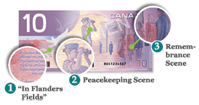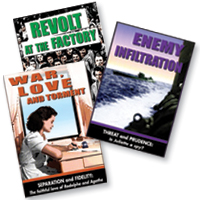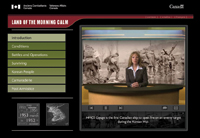Canada Remembers Times - 2010 Edition - Page 4
The Vanier Cup

Major Georges Vanier in 1918.
Photo: LAC PA-002777
The Vanier Cup is awarded each year to the Canadian university football champion. The cup is named after Major-General Georges Vanier, a Canadian soldier and diplomat. He served as an officer in the 22nd Battalion of the Canadian Expeditionary Force during the First World War, losing his right leg. Vanier received a number of decorations including the Military Cross, and served again in the Second World War. He became the first French-Canadian Governor General of Canada. An avid sports fan, he created the Vanier Cup in 1965.
A Youth Remembers

Conal Slobodin sprinkling Canadian soil on soldier’s grave in the Netherlands.
Photo: VAC
In 2005, Conal Slobodin was a youth delegate on a Veterans Affairs Canada overseas event marking the liberation of the Netherlands. Travelling with many Veterans who had helped liberate the country had a great impact on the young man from the Yukon.
“I was speechless (for the first time in my life) as I sat talking to these men who, sixty years ago, were my age, and had donned a uniform and fought in a war that would forever impact the world. ... I did not know how to thank them, and I still don’t today. ... Their courage and bravery go beyond our understanding of the mere words. As I often heard them say to me, ‘I never want it to happen to you.’ I thought, these men are true heroes.”
Did you know?

Mr. Babcock at age 107 and as a teenager
Photo: VAC
John “Jack” Babcock died on February 18, 2010 at the age of 109—the last known Canadian Veteran of the First World War. He lied about his age in order to enlist in the Canadian Army at age 15, but authorities discovered he was underage and sent him to train with a reserve battalion in Britain until he was older. The war ended before he could be sent to the front line.
Mr. Babcock’s passing marked the end of an era. It is up to all of us to remember Canadians’ service and sacrifice during the First World War. Visit www.veterans.gc.ca today and search for End of an Era to learn more.
Remembrance on the Road

Bouthillier’s truck at Canadian Forces Base Petawawa.
Photo: DND - Base Web Developer, Eric Traclet
Canadians have long put their lives on the line in the cause of peace and freedom. Remembering their achievements and sacrifices is a great way to honour their service. People do this in many ways.
In March 2009, 20-year-old Trooper Jack “Bouts” Bouthillier of Ontario was killed by a roadside bomb in Afghanistan. His father, Raynald Bouthillier, wanted a fitting way to honour his son and other Canadians who have died in Afghanistan. He modified one of his company’s trucks with pictures of “Bouts,” scenes from Afghanistan, and the names of all Canadians who have died in service there.
“V” for Victory Nickels

1945 and 2005 "V" for Victory nickels.
Photo: Terrill Dent
Winston Churchill, Prime Minister of Great Britain during the Second World War, helped popularize the “V For Victory” slogan in an effort to raise Allied spirits. The people of occupied Europe were urged to paint the letter “V” on the walls of buildings.
From 1942 until 1945, Canada replaced the traditional beaver with a torch superimposed on a “V” on the back of the Canadian nickel. “WE WIN WHEN WE WORK WILLINGLY” was also etched in Morse code.
More than twenty-five million of the “V for Victory” coins were minted in 1943 alone. In 2005, during the Year of the Veteran, the Canadian Mint released a special commemorative "V for Victory” nickel.
Remembrance in your Pocket

Bank note images used and altered with permission of the © Bank of Canada
Did you know that on the back of the Canadian $10 bill, you can find three remembrance-related illustrations? On the left is a verse from In Flanders Fields, the famous First World War poem by Canadian John McCrae. The center depicts a Canadian Forces peacekeeper, doves and a globe representing Canadian peace support efforts around the world. On the right is a Veteran and two youth participating in a Remembrance Day service at a cenotaph.
La force francophone

The contributions of French-Canadians during the Second World War, both on the home front and in the military, were many. Men and women recall their war experiences in this cool interactive Web feature. To learn about their stories, visit www.veterans.gc.ca today and search for La force francophone.
Korea – Land of the Morning Calm?

Veterans Affairs Canada has a new multimedia and interactive Web feature about the Korean War. Hear about the events leading up to the conflict, watch interviews with Canadian Veterans who were there, or explore an interactive time line and map. Visit www.veterans.gc.ca today and search for Land of the Morning Calm.
- Date modified: